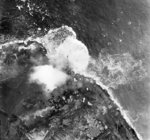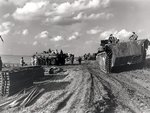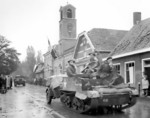Battle of the Scheldt Estuary
Contributor: C. Peter Chen
ww2dbase"Capture of the approaches to Antwerp was a difficult operation," recalled Dwight Eisenhower in his memoirs. However, it was much needed as another port for the war of supply the Allies was fighting in late 1944. After initial delay, Allied advances were now far beyond initial predictions, which was bittersweet as the supplies simply could not keep up with the rapidly advancing troops. The situation was made worst after foul weather on 19 Jun 1944 damaged harbors in the Normandy area. The capture of Antwerp, Belgium on 4 Sep 1944 did not yet bring relief to the supply situation, as the approaches to Antwerp, the Scheldt Estuary, were still under German control. Commonwealth troops under the command of Lieutenant General Guy Simonds were given the task of securing the Scheldt Estuary. Under Simonds' command was the Canadian 1st Army, consisted of the British 1st Corps and Canadian 2nd Corps (with a Polish armored division and two British divisions).
ww2dbaseThe terrain this region in the Netherlands and Belgium favored the defenders. The marshlands in the south impeded movement, the isthmus at South Beveland was easily defended, and the island of Walcheren was an island fortress. Defending this terrain was General Gustav-Adolf von Zangen's 15th German Army. The 15th German Army was beaten and chased by the Allies during the campaign for Antwerp, but a failure in strategy discontinued the chase, giving the German troops the time to further fortify the area. This strategic failure was largely attributed to Bernard Montgomery, who drew men and resources away from the Antwerp region for the failed Market Garden operation. "If I had not attempted the Arnhem operation", said Eisenhower, "possibly we could have begun the Walcheren attack some two or three weeks earlier."
ww2dbaseTo set up the operation against German forces in the region, in late Sep 1944 the 4th Canadian Armored Division moved against the Dutch town of Breskens while the 1st Polish Armored Division headed for the Dutch-Belgian border north and east of Antwerp.
ww2dbaseSouth Beveland
ww2dbaseOn 2 Oct, the 2nd Canadian Infantry Division marched north from Antwerp toward South Beveland, and met German resistance four days later. German troops took high ground atop the dykes that surrounded the estuary, and caused heavy losses among the Allied troops who fought from low and open flood lands. On 13 Oct, "Black Friday", the Canadian 5th Infantry Brigade's Black Watch Battalion faced especially tough German counterattack and was nearly wiped out completely. After ten days of fighting, on 16 October 1944 they took Woensdrecht, a town critical in the capture of the isthmus. Two weeks later, a combination of land and amphibious maneuvers attacked German positions at the isthmus. After another week of intense fighting, Canadian troops secured the eastern portion of the isthmus on 24 Oct. South Beveland was secured by the end of the month after the Operation Vitality offensive.
ww2dbaseDuring the campaign for South Beveland, Bernard Montgomery moved his British Second Army against German positions elsewhere in the Netherlands, successfully isolating the Scheldt Estuary region from outside German reinforcements or counterattacks.
ww2dbaseThe Southern Marshlands
ww2dbaseThe marshes south of the Scheldt Estuary was defended by German troops in an area the Allies named the Breskens pocket. The terrain posed the largest threat for the advancing Allied troops, where the flooded fields not only slowed the attackers, but it also provided cover for the defending German troops from both land and aerial reconnaissance. The 3rd Canadian Infantry Division's 7th Brigade moved across the Leopold Canal while the 9th Brigade mounted an amphibious attack on the northern coast on 6 Oct; the two Canadian brigades secured the area near the Aardenburg road by 12 Oct. Meanwhile, the 8th and 9th Brigades asserted pressure from different directions to overwhelmed the Germans in the pocket. This operation was named Operation Switchback, and it ended on 3 Nov after securing Knokke and Zeebrugge, eliminating German threat on the south coast of the Scheldt Estuary.
ww2dbaseWalcheren
ww2dbaseThe island stronghold of Walcheren was attacked from the air, with British Royal Air Force aircraft targetting dykes, flooding the island. The flooding hampered German movement, and also raised the water levels so that the Allies could have deeper water for an amphibious operation. As predicted by Eisenhower, the capture of this island "required a joint naval, air, and ground operation," and it was exemplified with this successful coordination between bombers and ground troops. On 31 Oct Canadian troops attacked across the single causeway between Walcheren and South Beveland, supported by an amphibious assault on 1 Nov from the south across the estuary. On 6 Nov, the island's capital Middelburg fell, and the island was declared secure two days later.
ww2dbaseAfter a month of fighting, the Allied victory came at a high cost of 12,873 casualties among the veterans of Falaise and Caen, half of them Canadian. Meanwhile, the victors captured 41,043 prisoners. With the hostile forces cleared from the area, time-consuming mine-clearing operations could finally begin. Antwerp opened as an Allied port on 28 Nov. "The end of Nazism was in clear view when the first ship moved unmolested up the Scheldt", said Eisenhower. This first vessel to arrive at Antwerp was appropriately the Canadian-built freighter Fort Cataraqui. The gallantry that the Canadian soldiers had shown amidst fierce fighting earned utmost respect of Montgomery. "The Canadians have proved themselves magnificent fighters. Clearing the Scheldt was a job that could have been done only by first-rate troops. Second-rate troops would have failed."
ww2dbaseBefore the estuary operation completed, German V-1 and V-2 weapons started to attack the port city of Antwerp. V-2s particularly caused considerable damage to the city, interrupting communications. However, the citizens of Antwerp "sustained these attacks unflinchingly", recalled Eisenhower. Despite the serious civilian deaths, Belgian citizens assisted wholeheartedly to transform Antwerp into "the northern bulwark of [the Allies'] entire logistical system."
ww2dbaseSources:
Dwight Eisenhower, Crusade in Europe
BBC
The Loyal Edmonton Regiment Museum
Wikipedia
Last Major Update: Aug 2005
Battle of the Scheldt Estuary Mapa Interativo
Photographs
 |  |  |  |
Battle of the Scheldt Estuary Timeline
| 27 set 1944 | Allied troops captured Helmond and Oss in the Netherlands. |
| 2 out 1944 | 2nd Canadian Infantry Division marched north from Antwerp, Belgium toward South Beveland, the Netherlands. |
| 5 out 1944 | The Germans lost 36 Linsen boats - small motorboats packed with explosives - attempting to disrupt traffic in the Scheldt estuary controlling the approach to the port of Antwerp, Belgium. On the same day, Canadian forces entered the Netherlands, capturing Kerkrade. |
| 6 out 1944 | Canadian 3rd Division assaulted the German pocket at Breskena, Belgium, south of the Scheldt Estuary. To the north, Allied troops captured Ossendrecht, the Netherlands. |
| 9 out 1944 | Canadian troops used amphibious vehicles to enter the Breskens Pocket in the Netherlands. |
| 18 out 1944 | Allied troops captured Venray, the Netherlands. |
| 21 out 1944 | Canadian troops captured Breskens, the Netherlands. |
| 22 out 1944 | The Canadian II Corps launched an attack on Fort Frederick Hendriks, close to the mouth of the Scheldt, opposite Vlissingen (Flushing), The Netherlands. The Fort fell after three days heavy fighting. |
| 27 out 1944 | Allied troops captured Den Bosch, Tilburg, and Bergen op Zoom in the Netherlands. |
| 29 out 1944 | Allied troops captured Breda, the Netherlands. |
| 30 out 1944 | Allied troops captured Tholen and Goes in the Netherlands. |
| 31 out 1944 | Canadian troops reached Walcheren, the Netherlands. |
| 1 nov 1944 | Commandos and Royal Marines landed on Walcheren Island in the Netherlands to aid clearing German troops from Scheldt Estuary, capturing the towns of Vlissingen and Westkapelle. |
| 2 nov 1944 | Canadian 2nd Division withdrew from its Walcheren, the Netherlands bridgehead. Nearby, Allied troops captured Wissenkerke and Zoutelande. |
| 6 nov 1944 | The German garrison at Middelburg, the Netherlands surrendered to the Allies. |
| 8 nov 1944 | Allied troops captured Veere and Koudekerke in the Netherlands. |
| 9 nov 1944 | German troops on Walcheren Island, the Netherlands surrendered. Nearby, German troops withdrew from the Moerdijk bridgehead in the Netherlands across the Meuse River. |
| 28 nov 1944 | Allies began to operate the port in Antwerp, Belgium. |
| 3 dez 1944 | Allied troops captured Blerick, the Netherlands. |
Você gostou deste artigo ou achou este artigo útil? Se sim, considere nos apoiar no Patreon. Qualquer valor já vai ajudar! Obrigado. Por favor, ajude-nos a divulgar o site: Fique atualizado com WW2DB: |
Visitor Submitted Comments
12 Feb 2013 12:01:37 PM
My grandfather was Lawrence Vallely Hill Lt.Col 279455 21st Army group.have you any info on him.regards dave
19 Feb 2013 01:52:47 AM
My grandfather spent a long time during the war in Belgium,Brussels and Antwerp.In Antwerp he was in charge of the Ambulance and Fire service.During the Nuremberg Trials he was handcuffed to Josef Kramer.Ant information or help would be great.Regards Dave Hill
13 Sep 2014 08:42:13 AM
My father, Thomas Raymond (Ray) Cullinane was a Canadian soldier and fought in the battle of the Scheldt. Any information would be greatly appreciated.
21 Dec 2014 02:36:03 PM
Order your father's service records from http://www.collectionscanada.gc.ca/obj/022/f2/022-909.007-e.pdf. You'll have to provide proof of relationship and or his death. His regiment will be provided.
8 May 2015 01:03:45 AM
Let's not forget American soldiers also liberated significant parts of southern NL. The 104th Infantry DIV also was part of Canadian led force in Battle of the Scheldt Estuary.
31 Oct 2015 01:13:05 PM
Troops of the 2nd Canadian Infantry Division attacked across the causeway but had to withdraw. The exhausted Canadians went to Antwerp.
13 Dec 2016 07:17:05 AM
Tholen Island was liberated by the O.D. Tholen (Orde Dienst Tholen = Millitary Wing Dutch Reistance). This small resistance group fought K.G. Chill untill Canadian 4 Armoured Division liberted Nieuw-Vossemeer on November 2 1944. In doing so they may have prevented the famous F.J.R.6 being sent to 70 I.D. as support.
14 Mar 2017 01:23:00 PM
Montgomery? Who put him in charge anyway? Oh yes, Gallipoli Winston. The two guys who planned Operation Casket Garden.
13 Sep 2018 10:18:52 AM
Typo in former mesage .Must be untill November 4 1944. Additional footage popped up last year. October 30 1944: Resistancefighter+ 3 Canadian scouts are ferried to Tholen Island. https://youtu.be/xoiDgZF5bbk / +/- 15 minutes later scouts and District Commander+XO are ferried back to Halsteren. https://youtu.be/IXSvl_HbhDY . DC +XO receive orders to take Oud-Vossemeer.Keep it occupied and secure leftflank 4CAD / November 2 1944 Canadian scoutcar XII Manitoba Dragoons is ferried over to Dutch held Tholen Island for a recce to the Resistance posts at Oud-Vossemeer and Stavenisse. In an attempt to cross an unknown amount ( maybe up to 13 para's of III./Fallschirm Regt.6 are casulties) Resistance fighters C.Franken+Bou Kooiman KIA on Nov.2.German casulties from Sept 4 to October 4 between 70 and 90.After Nov.4 : Some +18 German POW's are ferried to Canadian lines.Clearly visable 1 parasmock https://youtu.be/OqsfvW_12Vc
4 Jun 2019 01:19:05 AM
The Belgium citizens of Antwerpen. Not the Dutch citizens, because they in majority don't live in Belgium.
4 Jun 2019 07:11:39 AM
Ahsan Aldo Pijlman, thanks for spotting the error. It has been corrected.
All visitor submitted comments are opinions of those making the submissions and do not reflect views of WW2DB.

» Hobart, Percy
» Maczek, Stanislaw
» Simonds, Guy
» Zangen, Gustav-Adolf
Locations:
» Belgium
» Netherlands
Related Book:
» The Battle for the Rhine
- » 1,181 biografias
- » 337 eventos
- » 45,111 entradas na linha do tempo
- » 1,246 navios
- » 350 modelos de aeronaves
- » 207 modelos de veículos
- » 376 modelos de armas
- » 123 documentos históricos
- » 261 instalações
- » 470 eventos
- » 28,472 fotos
- » 365 mapas
Lt. Gen. Lewis B. "Chesty" Puller, at Guadalcanal
Por favor, considere nos apoiar no Patreon. Mesmo R$1 por mês já faz uma grande diferença. Obrigado!
Ou, por favor, nos apoie adquirindo alguns produtos do WW2DB na TeeSpring. Obrigado!
27 Nov 2005 07:27:15 AM
Please help...I am looking for information, friends or photos of Pvt Elwood I. Schrader. (My father-in-law) He fought his way through Italy and Germany. He was captured on or around Oct 26, 1944. We have the original post card letting the family know he was captured but was in good health. He was part of the 1st Inf Div. If anyone knows him please contact me. Thanks